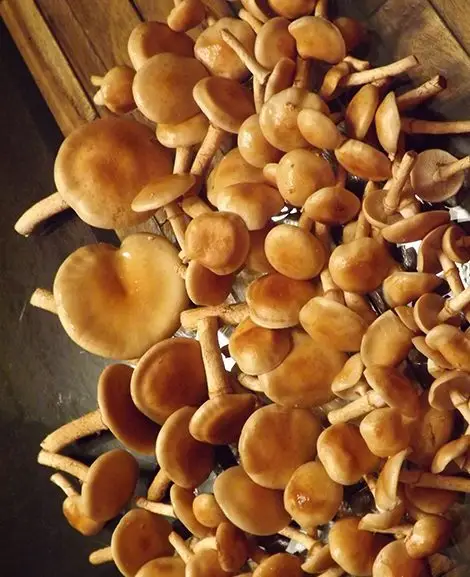
A small, amber-colored mushroom highly prized in East Asian cuisine, especially in Japan. Known for its slightly gelatinous texture when cooked and its delicate, earthy flavor, Pholiota nameko is considered a gourmet mushroom, sought after by chefs and food enthusiasts alike. This mushroom not only enhances dishes with its unique flavor profile but also provides nutritional benefits, making it a popular choice in various culinary applications. Moreover, the use of liquid culture in growing Pholiota nameko has increased its accessibility to both home cultivators and commercial mushroom farmers.
Pholiota nameko is easily recognized by its small, orange-brown cap, which often becomes slimy or sticky when wet—this texture is a hallmark feature of the species. The cap, about 1-4 cm in diameter, sits atop a slender white to brownish stem. This characteristic slimy coating, known as a viscid cuticle, is one of the defining traits of the mushroom and is highly appreciated in culinary traditions. When cooked, the slime layer adds a pleasant, thickened texture to soups, sauces, and stir-fries.
The gourmet mushroom is also highly nutritious, containing a range of vitamins, minerals, and antioxidants, including B vitamins, potassium, and fiber. Nameko mushrooms are low in calories but rich in umami flavor, making them a great addition to a healthy diet.
In the culinary world, Pholiota nameko is valued for its versatility. It is often used in Japanese dishes like miso soup and nabemono (hot pot), where the mushroom’s gelatinous texture helps to thicken the broth and adds depth to the flavor. Its rich, savory taste complements many recipes, especially when paired with other vegetables, tofu, or noodles. When sautéed, the nameko mushroom releases its natural gelatinous coating, which creates a glossy sheen and enhances the overall texture of the dish.
Due to its unique texture and flavor, Pholiota nameko has earned a reputation as a gourmet mushroom, making it a desirable ingredient in high-end restaurants and home kitchens alike. Its availability in fresh and dried forms allows it to be incorporated into various cuisines, from traditional Asian dishes to modern fusion cooking.
The cultivation of Pholiota nameko can be a challenging task for beginners, but advancements in mushroom cultivation techniques, particularly liquid culture, have made growing this gourmet mushroom more accessible. Liquid culture involves growing the mycelium—the vegetative part of the fungus—in a nutrient-rich liquid medium. This method allows the mushroom to establish a strong foundation of healthy mycelium before being introduced to a solid substrate, which is essential for fruiting.
Here’s how liquid culture benefits the cultivation of Pholiota nameko:
Using liquid culture to grow Pholiota nameko requires precise control over temperature and humidity, as this mushroom prefers cooler, moist environments similar to the conditions found in its natural habitat. Cultivators often replicate these conditions by growing the mushrooms indoors or in controlled greenhouses.
Whether you are growing Pholiota nameko mushrooms at home or on a larger commercial scale, the process can be highly rewarding, especially when using liquid culture as a starting point. The mushroom typically fruits within a few months of inoculating the substrate, and multiple flushes (harvests) can be expected from a well-maintained substrate. This makes it a sustainable crop for both gourmet chefs looking for a consistent supply of fresh nameko mushrooms and for home cultivators who want to explore growing this unique species.
In commercial settings, nameko mushrooms are often grown on sterilized sawdust blocks or logs, which can produce abundant harvests. The use of liquid culture streamlines the production process by ensuring that the mycelium is robust and ready for fruiting when introduced to the growing medium. Commercial growers often prefer liquid culture due to its efficiency and ability to produce high yields of gourmet mushrooms in a controlled environment.
Pholiota nameko, with its distinctive texture, delicious flavor, and impressive nutritional profile, is one of the most sought-after gourmet mushrooms. Its cultivation has been made more accessible through the use of liquid culture, a technique that accelerates mycelium growth, ensures sterility, and provides a scalable solution for both home and commercial mushroom growers. Whether used in traditional Japanese cuisine or creative gourmet dishes, the nameko mushroom continues to be a favorite in kitchens worldwide. Its successful cultivation through liquid culture offers an exciting opportunity for mushroom enthusiasts to grow this culinary treasure with relative ease and high success rates.
| Weight | 6.0 oz |
|---|---|
| Dimensions | 9 × 2 × 2 in |

Stay updated with our newsletter for exclusive offers, insights, and the latest in psilocybe cubensis research.

At The Spore Depot, we are dedicated to providing the highest quality psilocybe cubensis mushroom spores for research purposes. With an extensive selection of mushroom spores, our products meet the strictest quality standards, ensuring they are prepared under sterile conditions for optimal results. Whether you’re working with a spore syringe or creating a spore print for detailed analysis, we are committed to supporting your journey into the microscopic world.
Our exceptional contact customer service is here to assist you every step of the way, making sure your experience with psilocybe cubensis spores is both rewarding and insightful. At The Spore Depot, your satisfaction is our top priority as you explore the fascinating world of fungi.